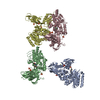+ Open data
Open data
- Basic information
Basic information
| Entry | Database: EMDB / ID: EMD-3840 | |||||||||
|---|---|---|---|---|---|---|---|---|---|---|
| Title | Negative-stain surface of human SorCS2 dimer | |||||||||
 Map data Map data | Negative-stain surface of human SorCS2 dimer | |||||||||
 Sample Sample |
| |||||||||
| Biological species |   Homo sapiens (human) Homo sapiens (human) | |||||||||
| Method |  single particle reconstruction / single particle reconstruction /  negative staining / Resolution: 27.0 Å negative staining / Resolution: 27.0 Å | |||||||||
 Authors Authors | Moeller A / Januliene D | |||||||||
| Funding support |  Denmark, 1 items Denmark, 1 items
| |||||||||
 Citation Citation |  Journal: J Mol Biol / Year: 2017 Journal: J Mol Biol / Year: 2017Title: Hidden Twins: SorCS Neuroreceptors Form Stable Dimers. Authors: Dovile Januliene / Arulmani Manavalan / Peter Lund Ovesen / Karen-Marie Pedersen / Søren Thirup / Anders Nykjær / Arne Moeller /   Abstract: SorCS1, SorCS2 and SorCS3 belong to the Vps10p-domain family of multiligand receptors. Genetic and functional studies have linked SorCS receptors to psychiatric disorders, Alzheimer's disease and ...SorCS1, SorCS2 and SorCS3 belong to the Vps10p-domain family of multiligand receptors. Genetic and functional studies have linked SorCS receptors to psychiatric disorders, Alzheimer's disease and type 2 diabetes, demonstrating critical roles in neuronal functionality and metabolic control. Surprisingly, their structural composition has so far not been studied. Here we have characterized SorCS1, SorCS2 and SorCS3 using biochemical methods and electron microscopy. We found that their purified extracellular domains co-exist in stable dimeric and monomeric populations. This was supported by co-immunoprecipitation experiments, where membrane-bound dimers were successfully pulled down from cell lysate. While dimers were virtually unbreakable, dimerization of the monomeric population was promoted through enzymatic deglycosylation. We conclude that post-translational modifications, specifically the degree and pattern of glycosylation, regulate the oligomeric state of the protein. Hence, cells may dictate ligand specificity by controlling the ratio between monomers and dimers and, therefore, regulate the multiple functions of SorCS receptors. | |||||||||
| History |
|
- Structure visualization
Structure visualization
| Movie |
 Movie viewer Movie viewer |
|---|---|
| Structure viewer | EM map:  SurfView SurfView Molmil Molmil Jmol/JSmol Jmol/JSmol |
| Supplemental images |
- Downloads & links
Downloads & links
-EMDB archive
| Map data |  emd_3840.map.gz emd_3840.map.gz | 3.1 MB |  EMDB map data format EMDB map data format | |
|---|---|---|---|---|
| Header (meta data) |  emd-3840-v30.xml emd-3840-v30.xml emd-3840.xml emd-3840.xml | 9.1 KB 9.1 KB | Display Display |  EMDB header EMDB header |
| Images |  emd_3840.png emd_3840.png | 30.9 KB | ||
| Archive directory |  http://ftp.pdbj.org/pub/emdb/structures/EMD-3840 http://ftp.pdbj.org/pub/emdb/structures/EMD-3840 ftp://ftp.pdbj.org/pub/emdb/structures/EMD-3840 ftp://ftp.pdbj.org/pub/emdb/structures/EMD-3840 | HTTPS FTP |
-Related structure data
- Links
Links
| EMDB pages |  EMDB (EBI/PDBe) / EMDB (EBI/PDBe) /  EMDataResource EMDataResource |
|---|
- Map
Map
| File |  Download / File: emd_3840.map.gz / Format: CCP4 / Size: 3.4 MB / Type: IMAGE STORED AS FLOATING POINT NUMBER (4 BYTES) Download / File: emd_3840.map.gz / Format: CCP4 / Size: 3.4 MB / Type: IMAGE STORED AS FLOATING POINT NUMBER (4 BYTES) | ||||||||||||||||||||||||||||||||||||||||||||||||||||||||||||
|---|---|---|---|---|---|---|---|---|---|---|---|---|---|---|---|---|---|---|---|---|---|---|---|---|---|---|---|---|---|---|---|---|---|---|---|---|---|---|---|---|---|---|---|---|---|---|---|---|---|---|---|---|---|---|---|---|---|---|---|---|---|
| Annotation | Negative-stain surface of human SorCS2 dimer | ||||||||||||||||||||||||||||||||||||||||||||||||||||||||||||
| Voxel size | X=Y=Z: 3.15 Å | ||||||||||||||||||||||||||||||||||||||||||||||||||||||||||||
| Density |
| ||||||||||||||||||||||||||||||||||||||||||||||||||||||||||||
| Symmetry | Space group: 1 | ||||||||||||||||||||||||||||||||||||||||||||||||||||||||||||
| Details | EMDB XML:
CCP4 map header:
| ||||||||||||||||||||||||||||||||||||||||||||||||||||||||||||
-Supplemental data
- Sample components
Sample components
-Entire : hSorCS2
| Entire | Name: hSorCS2 |
|---|---|
| Components |
|
-Supramolecule #1: hSorCS2
| Supramolecule | Name: hSorCS2 / type: complex / ID: 1 / Parent: 0 |
|---|---|
| Source (natural) | Organism:   Homo sapiens (human) Homo sapiens (human) |
| Recombinant expression | Organism:   Mus musculus (house mouse) Mus musculus (house mouse) |
| Molecular weight | Theoretical: 250 KDa |
-Experimental details
-Structure determination
| Method |  negative staining negative staining |
|---|---|
 Processing Processing |  single particle reconstruction single particle reconstruction |
| Aggregation state | particle |
- Sample preparation
Sample preparation
| Concentration | 0.01 mg/mL |
|---|---|
| Buffer | pH: 8 |
| Staining | Type: NEGATIVE / Material: Uranyl Formate |
- Electron microscopy
Electron microscopy
| Microscope | FEI TECNAI SPIRIT |
|---|---|
| Electron beam | Acceleration voltage: 120 kV / Electron source: LAB6 |
| Electron optics | Illumination mode: FLOOD BEAM / Imaging mode: BRIGHT FIELD Bright-field microscopy Bright-field microscopy |
| Image recording | Film or detector model: TVIPS TEMCAM-F416 (4k x 4k) / Average electron dose: 8.0 e/Å2 |
| Experimental equipment |  Model: Tecnai Spirit / Image courtesy: FEI Company |
- Image processing
Image processing
| CTF correction | Software - Name: CTFFIND (ver. 3) |
|---|---|
| Startup model | Type of model: RANDOM CONICAL TILT / Random conical tilt - Tilt angle: 50 degrees |
| Initial angle assignment | Type: PROJECTION MATCHING |
| Final angle assignment | Type: PROJECTION MATCHING |
| Final reconstruction | Applied symmetry - Point group: C1 (asymmetric) / Resolution.type: BY AUTHOR / Resolution: 27.0 Å / Resolution method: FSC 0.143 CUT-OFF / Software - Name: RELION (ver. 2.0) / Number images used: 1738 |
 Movie
Movie Controller
Controller














